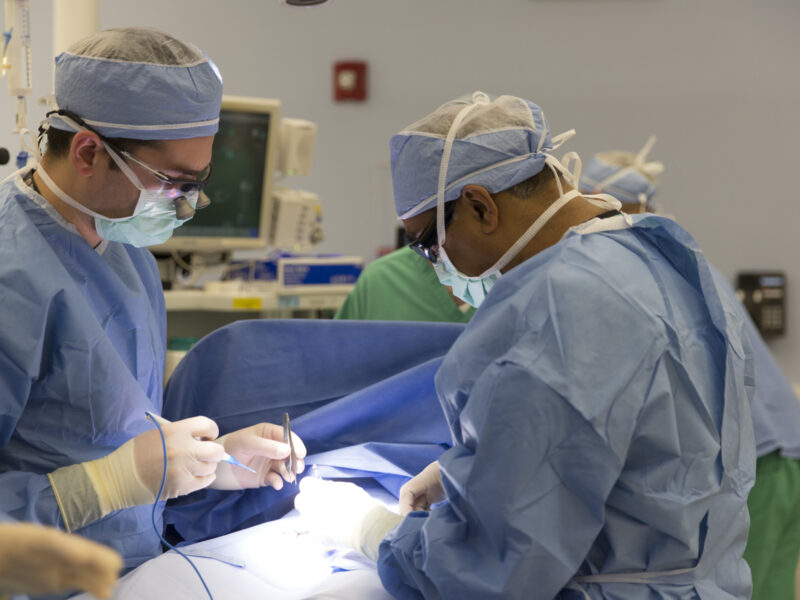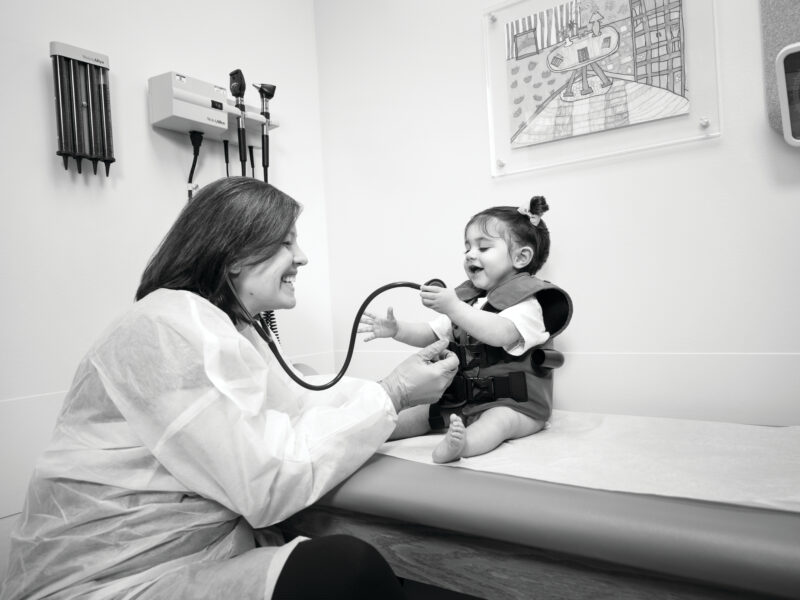Linking Structure and Function in Children With 22q11.2 Deletion Syndrome
Linking Structure and Function in Children With 22q11.2 Deletion Syndrome https://pediatricsnationwide.org/wp-content/uploads/2019/12/081611bs135-therapy-22q_HR_GS-1-1024x575.jpg 1024 575 Kevin Mayhood Kevin Mayhood https://secure.gravatar.com/avatar/bd57a8b155725b653da0c499ae1bf402?s=96&d=mm&r=g- December 02, 2019
- Kevin Mayhood

Children with 22q11.2 deletion syndrome commonly have velopharyngeal dysfunction (VPD), affecting speech and swallowing. A recent series of studies finds that anatomy of their soft palate and associated bony structures and muscles differ from children who don’t have the syndrome.
The findings suggest that these differences may be associated with speech, hearing and middle ear dysfunction. Most notably, the investigators found that the more abnormal the tensor veli palatini muscle, the more severe the hearing and/or middle ear issues a child with the syndrome has.
The studies come from what researchers believe is the first and largest use of magnetic resonance imaging to compare the velopharyngeal (VP) and related anatomy of unsedated children with and without 22q11.2 deletion syndrome, referred to as 22q.
“In children with VPD, the velopharyngeal valve doesn’t function normally, allowing too much air and sound to flow through the nose during speech. That, along with the often-associated errors in articulation, can lead to speech that can be hard for others to understand,” says Richard Kirschner, MD, FACS, FAAP, chief of Plastic and Reconstructive Surgery, director of the Cleft Lip and Palate-Craniofacial Center and co-director of the 22q Center at Nationwide Children’s Hospital.
“But, what is it about 22q patients that predisposes them to high rates of VPD? Are there anatomic differences related to the genetic disorder? These studies get to that question.”
Dr. Kirschner and Adriane Baylis, PhD, CCC-SLP, a craniofacial speech pathologist, director of the Velopharyngeal Dysfunction Program and co-director of the 22q Center at Nationwide Children’s, are co-authors of the three studies, all published in The Cleft Palate-Craniofacial Journal. These studies were conducted at Nationwide Children’s in collaboration with the MRI research team at East Carolina University, including Jamie Perry, PhD, and Lakshmi Kollara, PhD.
UNDERSTANDING A COMMON 22Q FEATURE
Investigators estimate that one in 2,000 to 4,000 children are born with 22q. The children lack a sequence of about 3 million DNA base pairs in the middle of one copy of chromosome 22 in their cells, at the location q11.2. The syndrome can affect almost every organ system but even from parent to child, symptoms can vary greatly.
Children typically have only some of the nearly 200 symptoms that can be associated with the syndrome. These can include heart disease, immune disorders, feeding and gastrointestinal problems, attention-deficit/hyperactivity disorder, autism spectrum disorder and, later in life, mental illness.
The syndrome is the most common genetic cause of VPD, which affects up to 80% of kids with 22q by some estimates. About 95% of kids with 22q will require speech therapy, but the severity or number of medical features don’t predict the severity or number of developmental or speech problems, Dr. Baylis says.
To study the connection between 22q and VPD, the researchers scanned 15 unsedated children with 22q and 15 sex- and age-matched control participants with MRI. They analyzed images of velopharyngeal structures and muscles, the cranial base, the tensor veli palatini muscle.
“First, we showed we could successfully scan young children without sedation,” says Dr. Baylis who is also an assistant professor of Clinical Plastic Surgery, Speech and Hearing Science and Pediatrics at The Ohio State University College of Medicine. That provides benefits to research and “potentially has clinical applications in the future, to obtain information that may be helpful for surgical planning.”
The researchers say child life specialists at Nationwide Children’s, who help children and families cope with demanding health care experiences, were key to collecting the data. “Scanning any 4-year-old without sedation is challenging, let alone a 4-year-old with 22q who may have developmental delays and anxiety,” says Dr. Baylis. “I credit them for helping us get as many kids successfully scanned as we did.”
SIGNIFICANT DIFFERENCES AMONG IMAGES
In the VP structural and muscle study, the investigators showed that in children with 22q, the velum was on average 23% thinner and pharyngeal depth 20% greater compared to the control group. Velar length between the groups did not differ, resulting in a significantly larger VP ratio among children with 22q.
The levator veli palatini muscle, which helps contract and elevate the soft palate during speech and swallowing, was significantly different in children with 22q: 8% shorter, 20% thinner and the origin-to-origin distance was 16% shorter than in the control group. The levator angles of origin were also 12% larger for the 22q group.
The variations in the dimensions of the VP valve, levator muscle and related structures may contribute to VPD, the researchers suggest.
Earlier studies have suggested that there may be syndrome-specific VP differences in 22q, but “in this study we were able to match our kids to kids of same age and gender,” Dr. Baylis says. “That helps control a lot of the noise in other studies that have been published, which didn’t control for age, gender and size.”
In the analysis of cranial base abnormalities, the images showed that the mean cerebellar volume of the 22q group was 16,302 cubic millimeters (mm) smaller than the control group and that the cranial base angles were significantly more obtuse among children with 22q.
The researchers found evidence suggesting craniofacial and velopharyngeal variables are more tightly related in the 22q group than controls. The study also suggests there could be subgroups of children, such as those with severe hypernasality more strongly correlated with an increased cranial base angle, decreased cerebellar volume and velar length.
Their study of the tensor veli palatini, which opens the eustachian tube and is tied to middle ear function, showed significant differences between the groups. The mean muscle was 1.7 mm shorter, .7mm thinner and its volume nearly 210 cubic mm smaller among children with 22q.
By comparing retrospective data from the children’s medical records to muscle measurements, the researchers showed that the more abnormal the tensor, the more severe the ear and hearing consequences.
“Hearing issues are highly correlated with the speech and language deficits this population is known to have,” says Ursula Findlen, PhD, an audiologist and director of audiology research in the Division of Clinical Therapies at Nationwide Children’s Hospital, and senior author of the tensor muscle study. “If you can’t hear it, you can’t say it.”
“If these children have hearing loss, they are more likely to have a hypoplastic tensor veli palatini,” says Dr. Findlen, who is also an assistant professor of Clinical Otolaryngology – Head and Neck Surgery at The Ohio State University College of Medicine.
Jonathan Grischkan, MD, a member of the physician teams in Ear, Nose & Throat (Otolaryngology) Services and the 22q Center, and a study co-author, helped guide the clinical ear and hearing-related measures, and provided guidance on how to measure the TVP muscle and angles.
“There’s not a direct clinical application yet but the findings may guide additional studies, and potentially impact the way we treat middle ear and hearing problems going forward,” says Dr. Grischkan, who is also a professor of Clinical Otolaryngology – Head and Neck Surgery at The Ohio State University College of Medicine.
The three studies, however, reinforce an individualized approach to VPD surgery and general speech and hearing management in 22q,” says Dr. Kirschner, who is also a professor of Clinical Plastic Surgery at The Ohio State University College of Medicine.
“Management of VPD requires surgery,” Dr. Kirschner continued. “If you look at historically published results, surgical outcomes reported for children with 22q are historically poorer than in those without the syndrome,nd revision rates to make surgery work after it has failed are higher.”
“Each of these kids presents with their own unique differences in VP structure and function,” he says. “We’ve found that by tailoring surgery to these specific differences—now better defined with these studies—outcomes for kids with 22q can now be the same as for those with VPD without 22q.”
GETTING THE WORD OUT
Those who study 22q refer to it as “the most common syndrome you’ve never heard of.”
Prior to the discovery they had the same missing genes, children displaying different 22q phenotypes were classified as having DiGeorge syndrome, velocardiofacial syndrome, conotruncal anomaly face syndrome or other syndromes according to their symptoms.
“Some people still use these old names and diagnostic silos,” Dr. Baylis says. “That can result in failure to provide children with 22q the comprehensive care they need.”
To help inform the field and pediatricians, Dr. Baylis and another research team produced a paper in the American Journal of Speech-Language Pathology, summarizing the currently available literature and describing best practices for speech-language disorders in 22q.
NEXT STEPS IN THE RESEARCH
Drs. Baylis and Kirschner and colleagues are studying the potential relationship between VP structural and functional variations and the relationship with speech correlates. They are also analyzing images taken while the same 30 children were speaking during the MRI scan, looking for more differences that may lead to improved diagnosis and treatment of VPD.
With Drs. Findlen and Grischkan, they’re scaling up for a larger, prospective and well-controlled longitudinal study investigating hearing and ear issues and 22q, including whether the anatomy associated with hearing issues in young childhood changes with age or remains a significant factor.
The researchers are also looking for early markers that would indicate which children are more likely to benefit from certain speech and hearing interventions and which are more likely to struggle and require novel approaches to management.
References:
- Kollara L, Baylis A, Kirschner R, Bates DG, Smith M, Fang X Perry JL. Velopharyngeal structural and muscle variations in children with 22q11.2 deletion syndrome: an unsedated MRI study. The Cleft Palate-Craniofacial Journal. 2019 Oct;56(9):1139-1148.
- Haenssler AE, Baylis A, Perry JL, Kollara L, Fang X, Kirschner R. Impact of cranial base abnormalities on cerebellar volume and velopharynx in 22q11.2 deletion syndrome. The Cleft Palate-Craniofacial Journal. 2019 Sep 10:1055665619874175.
- Perry JL, Kotlarek KJ, Spoloric MS, Baylis A, Kollara L, Grischkan JM, Kirschner R, Bates DG, Smith M, Findlen U. Differences in the tensor veli palatini muscle and hearing status in children with and without 22q11.2 deletion syndrome. The Cleft Palate-Craniofacial Journal. 2019 Aug 25:1055665619869142.
- Solot CB, Sell D, Mayne A, Baylis AL, Persson C, Oksana J, McDonald-McGinn DM. Speech-Language Disorders in 22q11.2 deletion syndrome: best practices for diagnosis and management. American Journal of Speech-Language Pathology. 2019 Aug 9;28(3):984-999.
Photo credit: Nationwide Children’s
About the author
-
Kevin Mayhoodhttps://pediatricsnationwide.org/author/kevin-mayhood/
-
Kevin Mayhoodhttps://pediatricsnationwide.org/author/kevin-mayhood/April 25, 2015
-
Kevin Mayhoodhttps://pediatricsnationwide.org/author/kevin-mayhood/April 25, 2015
-
Kevin Mayhoodhttps://pediatricsnationwide.org/author/kevin-mayhood/April 25, 2015
- Posted In:
- Features







